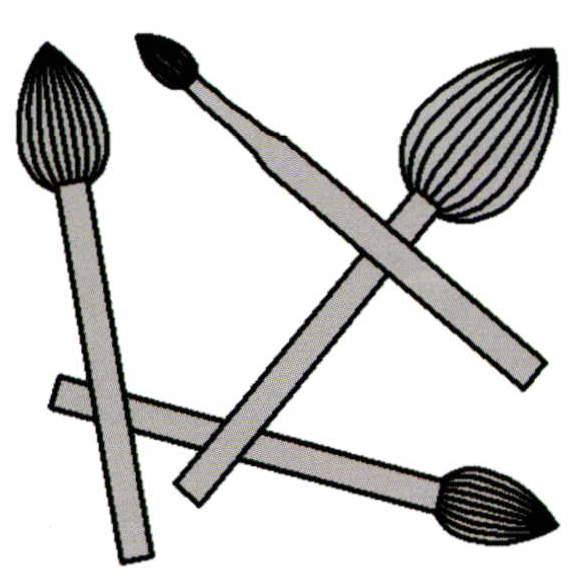Bud Bur Tool
3 Minute Read
Of all the burs used on a setters bench, my one good true friend is the bud bur. Why? Because it's one of the most diverse tools at our disposal. It is used for opening holes, cutting azures, cutting seats, as a mini-file. scalloping tool, and of course a drill to open a hole for setting a diamond/stone.
If this isn't a true friend at the bench, what else is?
Uses for Stone Setting Bud Bur Tool
The following are just some of the reasons why I prefer to make available and use this buddy called a bur.
Carving Out a Seat for a Baguettes Pavilion
I use a rather small #005 or # 006 bud bur to clean out the corners of the end-bezels and, of course, to prepare a girdle bearing for these stones. When attempting to clear out the metal for setting a straight or tapered baguette. I cut into the corners of the under carriage, to allow room for the corners of the baguette. I hold the bud bur shaft in a vertical upright position. Make sure that the corners of the diamond are totally free from touching any of the metal! Once this is done, with the bur still held upright, remove any left over cast metal along the four insides of the frame.
Adjusting Claws to Fit the Stone's Pavilion
In lieu ofa high speed steel 90 degree under cutting bur, I would suggest using a some what larger bud bur to create an angle for the pavilion in an engagement ring. There is a great tendency for the high speed steel bur to jump around the claw and cause indentations to the claws and consternation to the setter in repairing the claw.
Preparing a Groove for a Thicker Diamond
I use a #006 bud bur to accommodate the girdle of a diamond with a thick girdle when setting in an engagement head. Then I use a regular high speed steel 90 degree undercutting bur for the balance of the setting process. Use a bud shaped bur that is the same width as the stone's girdle thickness. I find it rather obvious not to use a l56C undercutting bur which has a fine girdle shape if the stone is of a wider thickness. All viewing should be done using a l0x power loupe
Cleaning Claws in a Cast Eternity Setting
Where claws are too close together or extra metal is filled in between them, instead of using the wider format of a triangular file, you can use a very small #004 or # 005 bur to actually remove extra metal to leave the claws in a more presentable shape. You can use the bur as a mini-file to carve away metal in between the two holes for the diamonds, leaving little posts for splitting into "shared claws".
Cutting Azures
To create an azure for the holes, under ready to be set diamonds, I use a very small bud bur #003 - #005. No diamonds should be mounted, when cut- ting the azures. You can create any design you wish as these very small closely-knit toothed bur can do wonders with your intricate hand made jewelry item.
Opening Holes
When setting diamonds into a plate, use a bud bur to open up the inside ofthe hole to accommodate the pavilion of the diamond. The bud bur size is limited only by the size of the diamond. This bur should allow a partial opening only and is not to be used for the final cutting of the seat.
Bezel Setting
When attempting to create a seat in a bezel, use a bud bur to act as an inside file. The bud bur has the correct angular proportions the stones pavilion. View the stone often as you are cutting to make absolutely sure that no facet edges are in contact with any metal. The angle of the burs side must match exactly with the pavilion of the stone. If there is any metal touching the stone during the hammering process, - good-bye stone!
What appeals to me is the wide variety of potential uses of this lonely little buddy. If you are not using it often, look around at the jobs you have and keep your eyes open to the vast range of possibilities and other labor saving methods that can be attempted. You'll soon wonder how you ever got along without this new buddy called a bud bur.
You assume all responsibility and risk for the use of the safety resources available on or through this web page. The International Gem Society LLC does not assume any liability for the materials, information and opinions provided on, or available through, this web page. No advice or information provided by this website shall create any warranty. Reliance on such advice, information or the content of this web page is solely at your own risk, including without limitation any safety guidelines, resources or precautions, or any other information related to safety that may be available on or through this web page. The International Gem Society LLC disclaims any liability for injury, death or damages resulting from the use thereof.
Gerry Lewy
With over 40 years experience as a stone setter, Gerry Lewy is known throughout the diamond setting community. Gerry started his 9-year apprenticeship with a jewelry manufacturer and tutored by a gentleman ‘setter’, in Haddon Gardens, London. Gerry has redeveloped himself into more than a master setter, his purpose is now to be a teacher of the art as well.
The All-In-One Jewelry Making Solution At Your Fingertips
When you join the Ganoksin community, you get the tools you need to take your work to the next level.
Trusted Jewelry Making Information & Techniques
Sign up to receive the latest articles, techniques, and inspirations with our free newsletter.
